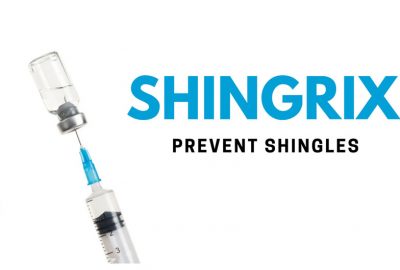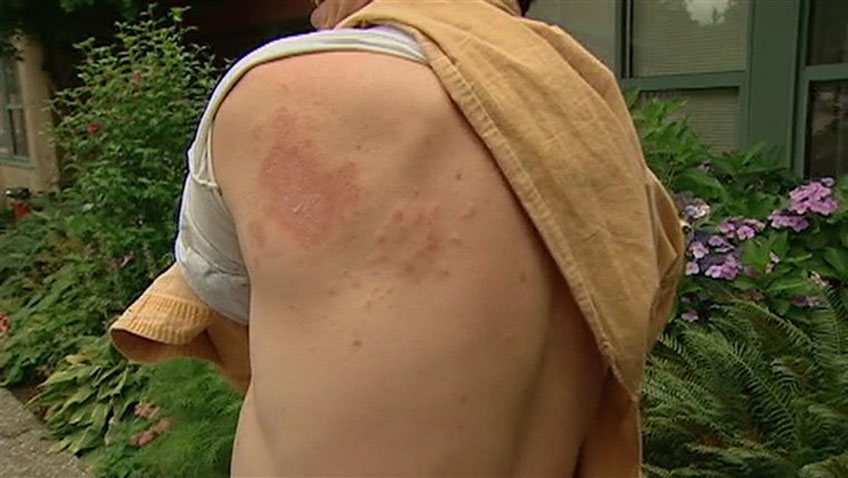Of the 95% of adults who’ve had chickenpox, around a quarter will go on to develop shingles — and it’s more likely to happen as you get older. It can be reactivated when your immune system weakens due to increasing age, stress, or certain conditions and treatments e.g. cancer or HIV.
What are the symptoms of shingles?
Generally, symptoms range from mild to severe. Shingles starts with some initial pain and tingling, before developing into a rash with blisters that can be itchy, painful and last for about 2-4 weeks. The rash usually only affects the upper body on one side, but can also develop on the head, neck and around the eyes.
Who’s at risk from shingles?
Anyone who’s had chickenpox is at risk of developing shingles, as the virus remains in certain nerves of the body and can become active again as time goes on. You may be at greater risk if you:
• Have a weakened immune system
• Are aged over 50
• Have become ill
• Are under significant stress
The Facts
Shingles are caused by varicella-zoster, the same virus that causes chickenpox. If you’ve ever had chickenpox (typically during childhood), this virus is quietly hiding out in the roots of your nerves. It can reactivate and cause a painful skin rash. This is known as shingles or herpes zoster.
Not everyone who has had chickenpox will develop a case of shingles. Approximately 1 in 3 North Americans develop shingles at some point in their life. Most people who get shingles are 50 to 70 years of age, but it can happen at any age.
Causes
The latent or “quiet” infection caused by varicella-zoster can become active again, even many years after you’ve had chickenpox. This can occur when your immune system isn’t working at its best. This may be due to any of the following reasons:
- older age
- illness
- use of medications that suppress the body’s immune system (e.g., corticosteroids)
- HIV infection or certain types of cancer
- radiation treatment
Most of the time, it is difficult to know exactly what triggered reactivation of the virus. Shingles rarely occur in children under the age of 10. The risks of getting it at that age increase significantly if a child has been infected with the virus during the first year of life, or if the mother had chickenpox during pregnancy.
A person with a shingles rash can pass the varicella-zoster virus onto someone who has not yet been infected with the virus, usually a child. However, the newly infected person would develop chickenpox, not shingles. Shingles occurs as a reactivation of the latent virus, not from “catching it” from someone who has shingles.
Symptoms and Complications
When the virus becomes active again, you may get symptoms such as rash, upset stomach, headache, fever, and chills. These symptoms are often preceded by warning signs (the prodrome) such as sensitivity, itchiness, numbness, or pain in the days before the rash appears. The rash produces painful, fluid-filled blisters, and you’ll feel tingling or burning sensations.
When the varicella-zoster virus enters its “quiet” phase after chickenpox, it remains dormant in certain nerves. The shingles rash will break out in the areas of the body connected to those nerve cells. As a result, only one section or one side of the body is often affected. Common sites for the rash include the chest, abdomen, back, buttocks, neck, and sometimes the face and scalp.
The rash itself is reddish, with many tiny, fluid-filled blisters. For a few days, the rash spreads, although its extent varies from one person to another. The rash commonly occurs on one side of the trunk of your body as a band of blisters that go from the middle of your back around one side of your chest to your breastbone. The blisters will break, dry out, and then crust over.
From before the time the rash erupts until after it’s healed, you’ll be itchy – in some cases, the rash can be extremely painful. The blister and rash usually lasts about 7 to 10 days and completely disappears after one month. The pain can last for up to 3 months or longer in a very small percentage of people. While you will likely have only one bout of herpes zoster, some people may get it several times.If your immune system isn’t working at full capacity, your rash and symptoms will be more severe and take longer to heal, which can lead to scarring. The virus can also spread to other organs in your body, but this is rare for people with healthy immune systems.
Post-herpetic neuralgia (PHN) is one of the complications of shingles. It is characterized by severe pain along affected nerves where the herpes zoster virus is located. It can last for several weeks, months, or years, and can be permanent. The cause of PHN is not known.
Other complications can occur if the virus spreads up the nerve that connects to your eyes. This may result in an eye infection or eye pain triggered by exposure to light. Your eye doctor should be consulted immediately if shingles in the eye area is suspected. If left untreated, the virus can cause blindness. If the virus spreads to two particular nerves in your face, then a condition called Ramsay Hunt syndrome can develop. This can lead to temporary ear pain, facial paralysis, and loss of hearing and taste.
Making the Diagnosis
With shingles, the rash is fairly characteristic and easy to identify. If necessary, your doctor can have the fluid from your blisters analyzed to see if it contains the varicella-zoster virus.
In order to reduce the chances of developing complications, it’s a good idea to see your doctor right away if you suspect you might have shingles.
Treatment and Prevention
Antiviral medications (e.g., acyclovir*, valacyclovir, and famciclovir) work best if started within 72 hours of developing the shingles rash. This will minimize the extent and spread of the rash and minimize the pain associated with it. Blisters will also crust over and heal faster. Antiviral medications may also help to reduce the risk of developing chronic pain from shingles.
There’s some evidence that starting treatment quickly with both antiviral medications and a course of oral steroids can lower your risk of developing PHN (severe pain along affected nerves), or at least shorten the duration of symptoms if you do get it.
Talk with your pharmacist about using over-the-counter medications such as ibuprofen or naproxen for the pain associated with shingles. If your pain is very severe, your doctor may prescribe other types of medications (e.g., pregabalin, or narcotic pain medications such as oxycodone) to help with the pain. Your doctor may also recommend an ointment containing capsaicin that can help to ease the pain of shingles.
To relieve the itching and pain of shingles, you can try:
- applying calamine lotion to the blisters
- using cool, moist compresses
- soaking in a tub with cornstarch or oatmeal
Keep the rash dry and clean, and avoid dressings and bandages with adhesives.
To prevent shingles, the first step is to avoid getting chickenpox. If you haven’t had it, make sure you don’t touch the blisters of people with either chickenpox or shingles. A vaccine against chickenpox is available for both children and adults. As more children become immunized, the incidence of chickenpox will go down and fewer people will be susceptible to developing shingles. There’s also Shingrix, a herpes zoster vaccine available for people 50 years of age or older which can help reduce the intensity and the duration of the pain caused by shingles.

If you’ve already had chickenpox, you can help prevent the virus from becoming active again and causing shingles by keeping your immune system healthy – a balanced diet, regular exercise, and adequate rest can go a long way to help.
Why get the vaccine?
Shingles can be very painful and the older you are, the worse it can be. Although most people fully recover from shingles, some can be left with long-term nerve pain that continues for months or even years after the blisters and rash have healed – this is called post-herpetic neuralgia (PHN).
The older you are, the higher the chance of developing PHN as a result of shingles. The vaccine not only helps reduce your risk of developing shingles, but can lessen the severity and duration of any symptoms if you do, as well as cutting your risk of developing PHN.
Who is suitable for the shingles vaccination?
It can be given to people aged 50 or over. You can have the vaccination year-round and can even choose to have it at the same time as the winter flu vaccination. And if you’ve had shingles before, you can still have the vaccination provided it’s been over 1 year since you have had shingles.
Who should NOT get the shingles vaccine?
It’s not recommended for those who have a condition, take medicines or are receiving treatment that weakens their immune system, pregnant women or anyone who’s had a previous shingles vaccination. You shouldn’t have the vaccine if you have a history of severe allergic reaction to any of the shingles vaccine components.
If you’re in any doubt, talk to your pharmacist, who can give you more information about the vaccination and advise whether it’s suitable for you.
*All medications have both common (generic) and brand names. The brand name is what a specific manufacturer calls the product (e.g., Tylenol®). The common name is the medical name for the medication (e.g., acetaminophen). A medication may have many brand names, but only one common name. This article lists medications by their common names. For information on a given medication, check our Drug Information database. For more information on brand names, speak with your doctor or pharmacist.
All material copyright MediResource Inc. 1996 – 2017. Terms and conditions of use. The contents herein are for informational purposes only. Always seek the advice of your physician or other qualified health provider with any questions you may have regarding a medical condition.
Source: www.medbroadcast.com/condition/getcondition/Shingles



